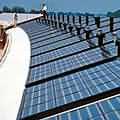|
記者:柏尼‧費屈洛維玆-羅柏特
美國,華盛頓特區,2002年4月2日--2001年6月,芝加哥市政府和48個市政府機構與當地電力公司ComEd簽約向該公司購買再生能源,作為各單位電力需求10%的來源,並計畫5年內提高採購比例至20%。

供應加州沙加緬度公用事業特區電力的風力發電設備。圖中人物保羅‧歐姆史泰得,為此處蒙特祖馬山電廠的資深計劃管理人,他負責控管這些設備。(大衛‧派森
攝,國家再生能源實驗室 提供)
這是美國境內最大宗的電力採購案,然而芝加哥只是眾多案例之一,許多城市、商業機構和個別家庭也正大量選購「綠色電力」;美國八個州的電力公司以及其他工業國家也紛紛開始銷售這類的產品。
英國的里玆首都大學於1999年10月開始購買綠色電力,供應該大學所需總電量30%以上。6個月之後,愛丁堡大學也簽約取得綠色電力,供應其電力總需求的40%。由於英國再生能源供應者可以免繳2001年4月起實施的氣候變遷稅,像這樣的能源利用轉換實際上是不花成本、甚至可以省錢的做法。
在荷蘭,綠色能源用戶數量光在過去一年裡就增加為3倍,達到77.5萬多戶,佔全國總人口5%。
綠色電力的用戶數目之所以能快速地成長,是因為荷蘭實施綠色電力免稅制、取消綠色能源管制、再加上成功的市場行銷。由於市場上出現供不應求的現象,目前有30%以上的綠色電力是由進口而來。
在德國,綠色電力用戶數大約是28萬人,許多大型的公司購買綠色電力,有益於創造綠色電力消費市場需求,使之超越石化燃料的消費市場。在洛拉茨市,一間大型「順勢醫療」(homeopathic medicine)公司Desdner Bank, Weleda AG,以及23家幼稚園,都完全使用綠色電力。(編按:順勢醫療與傳統的「對抗」症狀的療法相對,係引發人體的自癒能力來達成治病目的)
德國有一項完整的生態稅法修正案自1999年3月起生效,其中包括降低所得稅,針對與碳排放有關的能源來源加重課稅,並給予再生能源免稅的優惠。

世界上最大規模的住宅型太陽能光電板組,位於荷蘭阿默斯福特,架設在32間相連房屋的平坦屋頂上。(太陽能晶片製造商
BP Solarex 提供)
2000年2月,德國國會通過一項再生能源法案,其中規定用戶可將多餘的綠色電力賣回給電力公司,亦即將電表指針倒轉回來,減收用戶的電費。這些有助提升綠色電力成本效益的政策,對綠色電力計畫最終得以成功極為重要。
在澳洲,6萬個住宅用戶與近2,500個商業用戶,各佔有一半的綠色電力消費市場。到目前為止,大部分綠色電力的供應是來自生質能與水力發電,風能與太陽能只佔8%。然而,澳洲加速發展風能,因此,風電的市場佔有率正快速增加當中。
在美國科羅拉多州的「風力發電草根運動」(譯按:此由「落磯山脈土地與水資源基金會」發起,the LAW Fund),教育民眾有關風力發電的好處,並鼓勵民眾轉而購買風力發電。這項運動的成果是,該州有2萬戶住宅及無數商業用戶成為綠色電力訂戶,其中包含IBM、惠普、戶外服飾商Patagonia以及丹佛、柯林斯堡、亞斯本等城市,甚至州長官邸也購買綠色電力。
在2000年春季學期中,科羅拉多大學學生以壓倒性多數的投票結果,決定每學期多繳一美元學雜費,用以購買風電。這項增收的經費每年會有5萬美元,足以購買一座風力渦輪機,或2百萬度(千瓦─小時)的電力。
有相當多的美國商業公司和其他商業用戶也加入了這個行列。除豐田汽車、金可氏影印店(Kinko's)等大型知名公司外,許多較不知名的公司也開始將其環境價值與採購決策相結合。以加州哈普蘭的費澤葡萄園為例,它開始每年購買5百萬度的再生能源,用於釀造有機葡萄酒。
【文章連載】
■採購綠色電力蔚然成風
(上) (下)
全文與圖片詳見: http://ens-news.com/ens/apr2002/2002L-04-02-01.html
版權歸屬Environment News Service(ENS),環境資訊協會(李家淳 譯,莫聞 蔡麗伶 審校)
|
|
By Bernie Fischlowitz-Roberts
WASHINGTON, DC, April 2, 2002 (ENS) -In June 2001, the city of Chicago and 48 city government agencies signed a contract with local utility ComEd to purchase 10 percent of their electricity from renewable sources, a figure due to increase to 20 percent in five years.

Wind machines generate power for California's Sacramento Municipal Utility District, kept running by Paul Olmstead, senior project manager at this Montezuma Hills facility. (Photo by David Parsons courtesy
NREL)
This is the largest such purchase in the United States, but Chicago is just one example of the many cities, businesses, and individuals who are buying "green power." Utilities in eight states and many other industrial countries now offer such purchases.
In October 1999, Leeds Metropolitan University in the United Kingdom started buying at least 30 percent of its energy from green power. Six months later, Edinburgh University signed an agreement to obtain 40 percent of its energy this way. Since renewable energy sources in the United Kingdom are exempt from a climate change levy enacted in April 2001, making this switch is virtually cost free and can even save money.
The Netherlands has more than 775,000 green energy customers, which represents five percent of the population. The number of customers has tripled in just one year.
This rapid growth is due to an energy tax exemption for green electricity, green energy deregulation, and successful marketing campaigns. With Dutch demand outstripping supply, more than 30 percent of the green power used there is now imported.
Germany has approximately 280,000 green energy customers. Many large German companies are buying green power, helping to create consumer demand to move beyond fossil fuels. Dresdner Bank, Weleda AG, a large homeopathic medicine company, and 23 kindergartens in Lorrach all purchase 100 percent green power.
In March 1999, a comprehensive ecological tax reform law took effect in Germany that reduced income taxes, raised taxes on energy sources tied to carbon emissions, and exempted
renewables.

The world's largest residential solar photovoltaic project on 32 flat roofed houses in Amersfoort, Netherlands. (Photo courtesy
BP Solarex)
In February 2000, the parliament passed a renewable energies law that included payments for excess green energy generation fed back into the power grid; at those times, the meters run backwards, reducing customers' electric bills. These policies, which help make green energy cost-effective, are essential to the ultimate success of green power programs.
Australia's green power sales are evenly divided between 60,000 residential customers and almost 2,500 commercial ones. Most of the green energy supplied to date in Australia is derived from biomass and hydroelectric power, with only eight percent coming from wind or solar. With wind resource development accelerating, however, wind's share is increasing rapidly.
In the U.S. state of Colorado, the Grassroots Campaign for Wind Power has educated citizens about the benefits of wind power and encouraged a shift in purchasing behavior. As a result, Colorado has 20,000 residential green power subscribers and numerous commercial ones, including IBM, Hewlett-Packard, and Patagonia Clothing, as well as the cities of Denver, Fort Collins, and Aspen. Even the governor's mansion buys green power.
At the University of Colorado, students voted overwhelmingly during the spring of 2000 to raise student fees by $1 per semester in order to purchase wind power. This fee increase generates $50,000 per year, enough to buy the output of one wind turbine, or two million kilowatt-hours of electricity.
A large number of U.S. businesses and other commercial customers have also signed up. In addition to large, high profile companies like Toyota and Kinko's, lesser known companies are aligning their purchasing decisions with their environmental values. Fetzer Vineyards, for example, began buying five million kilowatt-hours of renewable energy annually for its organic wine operations in
Hopland, California.
http://ens-news.com/ens/apr2002/2002L-04-02-01.html
|
